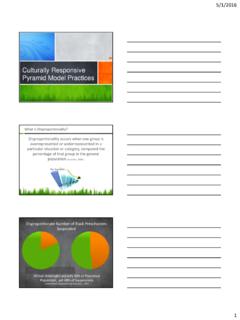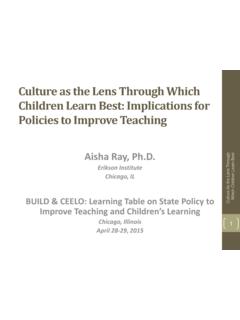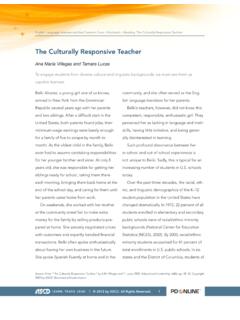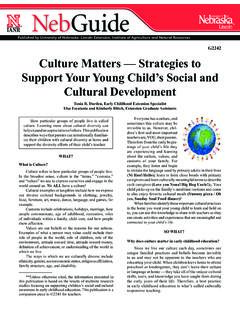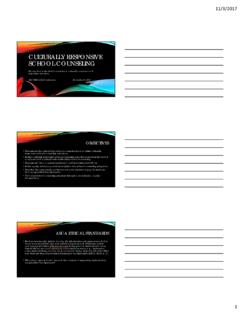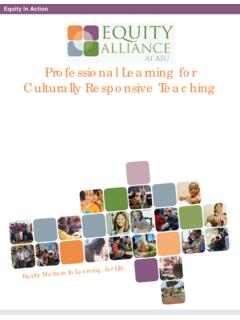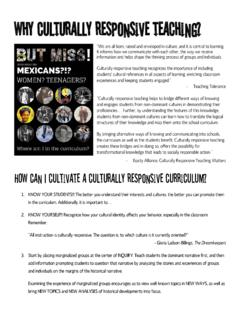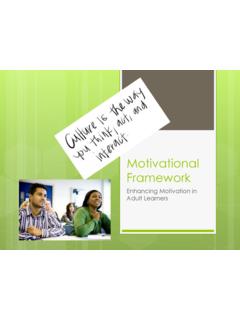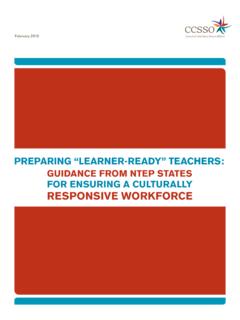Transcription of Gay Geneva-Culturally Responsive Teaching
1 culturally Responsive Teaching : Theory, Research, and Practice. geneva Gay. New York: Teachers College Press, 2000. 251 pp. BARRY OSBORNE. James Cook University, Cairns geneva Gay has been working for many years on matters of multicultural education and in this book draws together interesting case studies against a sound theoretical background. The first of eight chapters sets the tone for the rest of the book. In it Gay introduces us to a personalized dilemma: Why is it that students of color who are so successful in so many contexts outside school are so unsuccessful at school? She then provides five assertions that undergird the remaining chapters, which answer the question and suggest ways to deal with what she calls the "achievement dilemma.
2 " The assertions are that culture counts, conventional reform is inadequate, intention without action is insufficient, strength and vitality reside in cultural diversity, and test scores and grades are symptoms, not causes, of the achievement dilemma. She concludes with a call for culturally Responsive Teaching to unleash "the higher learning potentials of ethnically diverse students simultaneously cultivating their academic and psychosocial abilities." We also need to develop all students' relational competencies if we are to "avoid intergroup strife and individuals are to live the best- quality lives possible" (p. 20). Chapter 2 is the conceptual bridge between theory and practice, as well as between the nature of the achievement dilemma and resolutions of it.
3 Gay provides a historic overview of the origins of culturally Responsive Teaching , before broadly painting it as validating the values, prior experiences, and cultural knowledge of students, comprehensive, multidimensional, transformative, and emancipatory ("with cooperation, community, and connectedness central" [ ]). Then come two stories personifying culturally Responsive pedagogy. The first is from a teacher education class critiquing the notion that "K 12 education is a free, public, and equal access enterprise for all students in the United States." The second is of a kindergarten class in which the teacher was symboling (acknowledging/celebrating). ethnic and linguistic diversity.
4 The chapter concludes with discussion of appropriate roles and responsibilities for culturally Responsive teachers. The next four chapters provide substantial research support for the four cornerstones of culturally Responsive pedagogy, namely, the power of caring, culture and communication in the classroom, ethnic and cultural diversity in the curriculum and in media, and cultural congruity in Teaching and learning. In chapter 4 the Ebonics controversy is well analyzed, and so are issues of discourses and communication styles. Chapter 5 provides case studies of strategies that have been successful at various district level sites. In particular, Gay highlights the successes of the Multicultural Literacy Program in Michigan, the Webster Groves Writing Project in Missouri, the Rough Rock English-Navajo Language Arts Program, and the "Circles of Learning" of the Kikapoo Nation in Kansas.
5 In mathematics and science, Gay reviews the Teaching Excellence for Minority Student Achievement in Sciences project in Los Angeles; the Urban Schools Science and Mathematics Program in Atlanta, Cleveland, and Detroit; the Qualitative Understanding and Amplifying Student Achievement and Reasoning project in six school districts; EQUITY 2000 in over 20 school districts; project IMPACT for K 3 students;. the Comprehensive Enrichment Program; and the National Science Fair (the last two sponsored by the American Indian Science and Engineering Society). These programs and several smaller ones provide evidence that inroads can be made into the achievement dilemma. Chapter 6 deals with congruity between Teaching and learning strategies: learning styles, examples of multidimensional congruent instruction (Kamehameha Early Education Program, the Multicultural Literacy Program, and the Webster Grove Writing Project), cooperative learning, active and effective engagement (including using movement in learning), and ethnic-centered classes and schools.
6 Once again there are various strategies that successfully tackle the achievement dilemma. In chapter 7, Gay shares with us "some personal experiences" of " culturally Responsive praxis" ( ). She explains the need for and gives examples of being supportive and facilitative, rituals and routines, learning cooperatively and successfully, choice and authenticity as essential to learning, Teaching to enable and empower, knowledge plus practice as imperative, critical orientations as important, and the personal as powerful. She concludes this chapter with a strong call for praxis and "communitas.". The final chapter is a call to move forth that is both well informed and provocative.
7 Gay stresses the urgency of the task and the need for all to take the achievement dilemma in hand. She does not fall into the trap of preaching universal strategies but, rather, argues for praxis to link the ideas presented to specific sites and contexts. I would have liked more attention paid to assessment; the text shows that standardized test gains can result from culturally Responsive pedagogy. These gains can occur across school districts as various programs and projects are introduced and expanded. This is good news and encouraging for administrators and classroom teachers seeking to resolve their specific "achievement dilemmas" given that the task in hand often seems too big to handle.
8 But what if further forms of assessment were identified that allow us to tap into the skills, interests, and understandings of students like the two minority students Gay describes in chapter 1? Also, I would have liked some discussion of racism and of the impact of poverty/employment on student learning. Painting the "achievement dilemma". predominantly in terms of cultural diversity/sensitivity/responsivity runs the risk of oversimplifying it. Nevertheless, this is a timely and helpful response to the dilemma by one who has been tackling it for many years. 2000 American Anthropological Association. This review is cited in the December 2000 issue of Anthropology and Education Quarterly (31:4).
